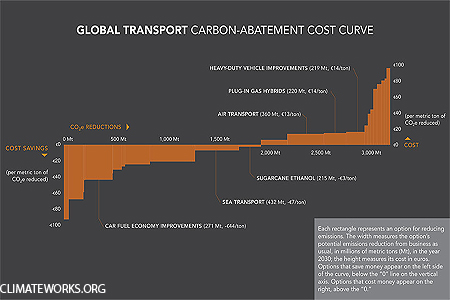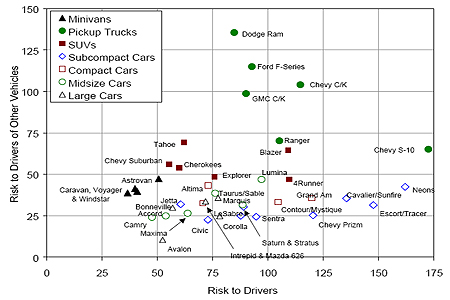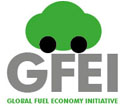
The Benefits of Action
-
Top Reasons
Environment and energy
Financial savings
Energy security
Trade harmonization
Fuel economy and vehicle safety
The benefits of the GFEI and the 50by50 campaign will include significant reductions in oil expenditures and reductions in urban air pollution around the world. For example, a move across the global fleet towards far better fuel economy at a scale which is already technically achievable, could save over six billion barrels of oil per year by 2050, and cut close to half of CO2 emissions from cars, as well as generate significant local air pollution benefits - and all using existing, cost-effective technologies.
Improving auto fuel efficiency is also one of the most cost-effective measures to reduce CO2 emissions within the transport sector and in carbon abatement options in general.

Environment & Energy
The average fuel economy of the global light duty vehicle fleet can be improved by at least 50 percent by 2050 relative to 2005 levels – from an average of 8 L/100 km to 4 L/100 km. Improvements of this order of magnitude appear possible in non-OECD countries where car fleets are growing fastest, as well as in OECD countries.
Even if vehicle kilometres driven double by 2050, efficiency improvements on this scale worldwide would effectively cap emissions of CO2 from cars at current levels. It is estimated that by 2025 over 1 Gt of CO2 emissions would be saved annually, rising to over 2 Gt of CO2 emissions by 2050 compared to business-as-usual. Additional vehicular pollutants that also impact on the environment and contribute to climate change, including black carbon, would also be significantly reduced.
Reducing the effects of climate change: see Climate Change
Financial Savings
Financial savings can be achieved through reducing the energy demand and petroleum imports of a country, thereby also improving energy security. The main focus of this is to reduce the emissions of CO2 from the motor vehicle fleet in order to help stabilize emissions from the road transport sector. Improvements in auto fuel result in estimated savings in annual oil import bills worth over USD 300 billion in 2025 and 600 billion in 2050 (based on an oil price of USD 100/bbl).
Reductions in transport CO2 emissions need not occur at the expense of economic growth. For many individuals, much or all of the cost of improved technology for more fuel efficient cars could be offset by the fuel saved in the first few years of use of a new car, especially at high oil prices. But unstable oil prices create risks that dissuade many car buyers from paying an upfront premium for efficiency and dissuade automobile manufacturers from investing in highly fuel efficient vehicles because they can not be sure of selling them.
Governments and their partners can take action to counter these risks and facilitate the introduction of cost effective fuel efficient technologies by
- Improving the information on fuel consumption and CO2 emissions available to consumers. For example, some fuel efficiency tests can be somewhat misleading as they do not accurately reflect average in-use fuel economy.
- Setting regulatory standards for fuel consumption or CO2 emissions that remove the uncertainty over how much investment in fuel efficiency is viable.
- Differentiating vehicle taxes according to CO2 emissions or fuel economy to encourage consumers to prefer improved efficiency.
- Providing incentives and set regulations for vehicle components that fall outside current vehicle testing, incentive and regulatory systems.
Energy Security
Keen on budgetary savings and improvements in environment and health, governments and their partners in the private sector are encouraged to adopt a more pro-active approach in setting efficiency targets and ensuring their cost-effective implementation.
According to international studies (including McKinsey 2009), improving automotive fuel efficiency is one of the most cost effective interventions to reduce GHG emissions. In addition, it also enables reduced government and consumer expenditure on oil. Many non-OECD countries are net fuel importers; increasing efficiency will lower dependency on expensive imports.
Trade and Harmonization
Governments also have a responsibility to minimize the costs of intervention, for example by keeping the differentiation of vehicle taxes simple and similar across regional markets and ensuring coherence with vehicle fuel efficiency labelling systems. Regionally and globally harmonized approaches to auto fuel economy can help reduction transaction costs for businesses and governments.
According to the Major Economies Forum : “…governments can help reduce manufacturing costs by harmonizing and/or aligning international regulations and testing methods. Differences in safety and emissions regulations currently complicate compliance and require duplicative efforts by manufacturers. International harmonization of standards and testing protocols could alleviate this compliance burden.This does not imply that all countries should adopt a single standard or test method, but that a higher degree of integration might be sought between countries and that robust international standards might be developed that can be adopted (or called-up) by countries developing regulations for advanced technology vehicles.”
Fuel Economy and Vehicle Safety: What are the tradeoffs?
Vehicle Size and Vehicle Safety
Does an increase in the size and weight of a vehicle result in greater levels of safety and security and, alternatively, will an increase in the fuel efficiency of a vehicle through a reduction in vehicle mass compromise the safety rating of the vehicle? Studies on the issue of tradeoffs between car size and efficiency show that being in a larger, heavier vehicle is not necessarily safer for the occupants of that vehicle, and especially not for those involved in a collision with a larger vehicle. The following graph indicates the risk to drivers and risk to drivers of other vehicles by vehicle type – heavy trucks and Sport Utility Vehicles (approximately > 4000lbs) are statistically shown no more safe on the road than midsize, compact or subcompact vehicles.
The crashworthiness of a vehicle is the “ability of a vehicle to protect its occupants in the event of a crash", and crash avoidance is “the ability of a vehicle, through manual and automated handling and braking, to avoid serious crash altogether”. Often, large vehicles are not more crashworthy than smaller vehicles, nor are they better at ‘crash avoidance’ than others. In many instances, the high roll-over factor in large SUVs makes them extremely poor at crash avoidance. In addition, SUVs often have higher degrees of ‘aggressivity’, which is “determined by designs that make a vehicle incompatible and more dangerous to others it comes into contact with".
Figure 1: Two Measures of Risk for Drivers by Vehicle Type and Model for the Most Popular Cars and Light Trucks from 1995-99

The main result of the Ross and Wenzel 2002 study is that "sport utility vehicles are not necessarily safer for their drivers than cars; on average, they are as risky as the average midsize or larger car, and no safer than many of the most popular compact and subcompact".
Fuel Efficiency and Safety
Does increased fuel efficiency require a compromise on the safety of light duty vehicles? The outcome of the International Council on Clean Transportation’s expert workshop on Simultaneously Improving Vehicle Safety and Fuel Economy through Improvements in Vehicle Design and Materials concluded that no trade-off exists between fuel efficiency and vehicle safety. The 2006 workshop made three important conclusions:
- “Vehicle fuel economy can be increased without affecting safety, and vice versa;
- Reducing the weight and height of the heaviest SUVs and pickup trucks will simultaneously increase both their fuel economy and overall safety;
- Advanced materials can decouple size from mass, creating important new possibilities for increasing both fuel economy and safety without compromising functionality”.
These findings assert that “most technologies to increase fuel economy do not affect safety – most technologies to increase safety do not affect fuel economy; there are many technical options for increasing vehicle fuel economy; reducing weight via material substitution is but one of many available strategies; strategically reducing car weight while improving vehicle structure, using advanced materials and designs, can simultaneously increase fuel economy and safety; and finally, reducing the weight of heavier SUVs and pickup trucks increases fuel economy and improves the safety of all vehicles on the road”.
New technologies and lighter materials can positively affect fuel efficiency while at the same time maintaining, or even increasing, the safety of vehicle passengers and the passengers of other vehicles, in the event of a collision.
Works Cited:
Ross, M. and Wenzel, T. "An Analysis of Traffic Deaths by Vehicle Type and Model." American Council for an Energy Efficient Economy, Washington, 2002: 1-22.
Ross, M. and Wenzel, T. "Increasing fuel efficiency and safety of new light-duty vehicles." White paper prepared for the William and Flora Hewlett Foundation’s Workshop on Simultaneously Improving Vehicle Safety and Fuel Economy through Improvements in Vehicle Design and Materials. 2006: 1-39.
“Sipping Fuel and Saving Lives: Increasing Fuel Economy Without Sacrificing Safety.” A Report Informed by an October 3, 2006, Experts Workshop on Simultaneously Improving Vehicle Safety and Fuel Economy Through Improvements in Vehicle Design and Materials. The International Council for Clean Transport, 2006.







